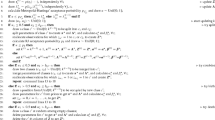Abstract
In a restricted class of item response theory (IRT) models for polytomous items the unweighted total score has monotone likelihood ratio (MLR) in the latent traitϑ. MLR implies two stochastic ordering (SO) properties, denoted SOM and SOL, which are both weaker than MLR, but very useful for measurement with IRT models. Therefore, these SO properties are investigated for a broader class of IRT models for which the MLR property does not hold.
In this study, first a taxonomy is given for nonparametric and parametric models for polytomous items based on the hierarchical relationship between the models. Next, it is investigated which models have the MLR property and which have the SO properties. It is shown that all models in the taxonomy possess the SOM property. However, counterexamples illustrate that many models do not, in general, possess the even more useful SOL property.
Similar content being viewed by others
References
Andrich, D. (1978). A rating scale formulation for ordered response categories.Psychometrika, 43, 561–573.
Bock, R. D. (1972). Estimating item parameters and latent ability when responses are scored in two or more nominal categories.Psychometrika, 37, 29–51.
Ellis, J. L., & Junker, B. W. (1995).Tail-measurability in monotone latent variable models. Manuscript submitted for publication.
Ellis, J. L., & van den Wollenberg, A. L. (1993). Local homogeneity in latent trait models. A characterization of the homogeneous monotone IRT model.Psychometrika, 58, 417–429.
Grayson, D. A. (1988). Two group classification in latent trait theory: Scores with monotone likelihood ratio.Psychometrika, 53, 383–392.
Hemker, B. T., Sijtsma, K., & Molenaar, I. W. (1995). Selection of unidimensional scales from a multidimensional item bank in the polytomous Mokken IRT model.Applied Psychological Measurement, 19, 337–352.
Hemker, B. T., Sijtsma, K., Molenaar, I. W., & Junker, B. W. (1996). Polytomous IRT models and monotone likelihood ratio of the total score.Psychometrika, 61, 679–693.
Holland, P. W. (1981). When are item response models consistent with observed data?Psychometrika, 46, 79–92.
Holland, P. W. (1990). On the sampling theory foundations of item response theory models.Psychometrika, 55, 577–601.
Holland, P. W., & Rosenbaum, P. R. (1986). Conditional association and unidimensionality in monotone latent variable models.The Annals of Statistics, 14, 1523–1543.
Huynh, H. (1994). A new proof for monotone likelihood ratio for the sum of independent bernoulli random variables.Psychometrika, 59, 77–79.
Junker, B. W. (1991). Essential independence and likelihood-based ability estimation for polytomous items.Psychometrika, 56, 255–278.
Junker, B. W. (1993). Conditional association, essential independence and monotone unidimensional item response models.The Annals of Statistics, 21, 1359–1378.
Junker, B. W., & Ellis, J. L. (1995).A characterization of monotone unidimensional latent variable models (CMU Statistics Department Tech. Rep. #614). Manuscript submitted for publication.
Lehmann, E. L. (1959, 1986).Testing statistical hypotheses. New York: Wiley.
Lord, F. M. (1980).Applications of item response theory to practical testing problems. Hillsdale, NJ: Erlbaum.
Masters, G. N. (1982). A Rasch model for partial credit scoring.Psychometrika, 47, 149–174.
Maydeu-Olivares, A., Drasgow, F., & Mead, A. D. (1994). Distinguishing among parametric item response models for polychotomous ordered data.Applied Psychological Measurement, 18, 245–256.
Mellenbergh, G. J. (1995). Conceptual notes on models for discrete polytomous item responses.Applied Psychological Measurement, 19, 91–100.
Mokken, R. J. (1971).A theory and procedure of scale analysis. New York/Berlin: De Gruyter.
Molenaar, I. W. (1982). Mokken scaling revisited.Kwantitatieve Methoden, 3 (No. 8), 145–164.
Molenaar, I. W. (1997). Nonparametric models for polytomous responses. In W. J. van der Linden & R. K. Hambleton (Eds.),Handbook of modern item response theory (pp. 369–380). New York: Springer.
Muraki, E. (1992). A generalized partial credit model: application of an EM algorithm.Applied Psychological Measurement, 16, 159–176.
Rosenbaum, P. R. (1984). Testing the conditional independence and monotonicity assumptions of item response theory.Psychometrika, 49, 425–435.
Rosenbaum, P. R. (1985). Comparing distributions of item responses for two groups.British Journal of Mathematical and Statistical Psychology, 38, 206–215.
Samejima, F. (1969). Estimation of latent trait ability using a response pattern of graded scores.Psychometrika Monograph, No. 17.
Samejima, F. (1972). A general model for free-response data.Psychometrika Monograph, No 18.
Stout, W. F. (1987). A nonparametric approach for assessing latent trait unidimensionality.Psychometrika, 52, 589–617.
Stout, W. F. (1990). A new item response theory modeling approach with applications to unidimensionality assessment and ability estimation.Psychometrika, 55, 293–325.
Thissen, D., & Steinberg, L. (1986). A taxonomy of item response models.Psychometrika, 51, 567–577.
Author information
Authors and Affiliations
Additional information
Hemker's research was supported by the Netherlands Research Council, Grant 575-67-034. Junker's research was supported in part by the National Institutes of Health, Grant CA54852, and by the National Science Foundation, Grant DMS-94.04438.
Rights and permissions
About this article
Cite this article
Hemker, B.T., Sijtsma, K., Molenaar, I.W. et al. Stochastic ordering using the latent trait and the sum score in polytomous IRT models. Psychometrika 62, 331–347 (1997). https://doi.org/10.1007/BF02294555
Received:
Revised:
Issue Date:
DOI: https://doi.org/10.1007/BF02294555




